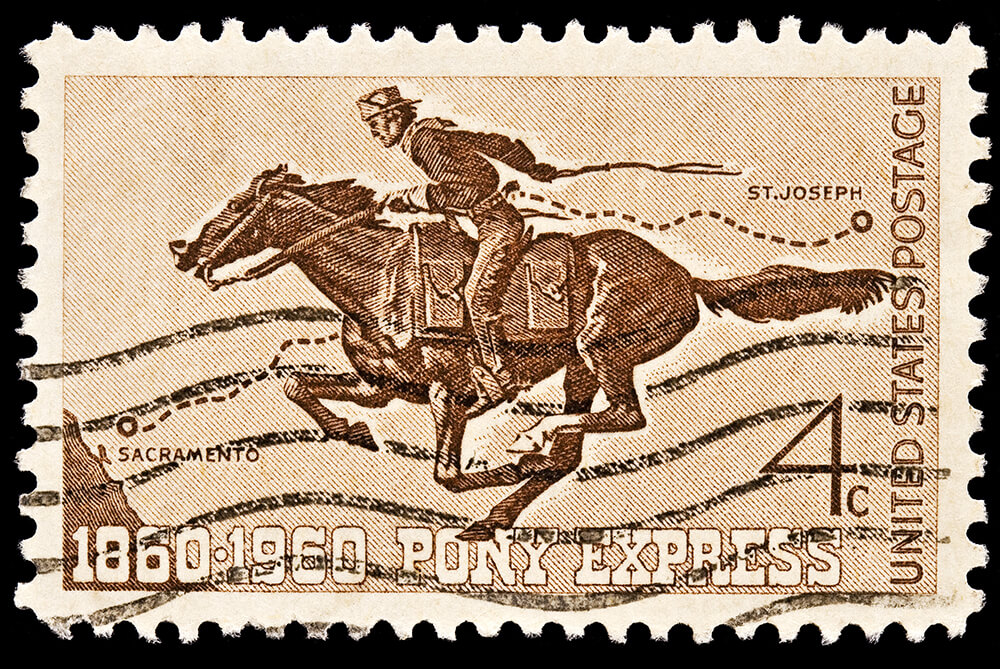The History of the Pony Express

Although the Pony Express was only in operation for 18 months, it is a powerful icon of the American Old West. This precursor to the modern postal service provided a way to deliver messages nationwide. It began in April 1860 and ceased operation in October 1861. In that time, it managed to secure a place in history and an influence that would last for generations.
Origins of the Pony Express
The horseback mail service concept dates back several centuries before the Old West. There are records of Marco Polo seeing messages delivered this way as far back as 13th Century China. So the practice might be even earlier.
However, the Pony Express was one of the longest routes in history, and its role in the country’s formation makes it incredibly iconic. The mail system was developed to speed up and improve communication between the east coast and California, whose population had dramatically exploded in the second half of the 1800s thanks to the Gold Rush. As half a million opportunistic Americans headed west and political tensions threatened Civil War back home, a reliable long-distance mail delivery service became a priority.
There were several attempts to establish a reliable coast-to-coast mail relay system. Still, none were efficient enough to satisfy the needs of the growing population until businessmen William H. Russell, Alexander Majors, and William B. Waddell stepped up to create what would come to be known as the Pony Express.
The Leavenworth & Pike’s Peak Express Company
Russell, Majors & Waddell was a freighting firm operated by Missouri businessmen. Their experience in overland freighting transferred well to the postal service, and they were eager to cash in on the financial support of the government offered by California Senator William Gwin. So, first, the team extended the route by utilizing preexisting routes between Salt Lake City and the Missouri River. Then, it set to hiring horses and crew for the job.
The Pony Express successfully delivered newspapers, letters, and packages nationwide. As a business venture, however, it failed. The high cost of competitive wages for riders and the expense of horse acquisition and maintenance added up quickly. As a result, the Pony Express lost approximately $200,000 by the end of its 16-month operation. In today’s currency, that would be a loss of over $5 million!
A Historical Legacy
Despite its short lifespan, the Pony Express remains an American icon because it boldly embodies the era of the Old West. The project combined American determination and ingenuity with a spirit of freedom, danger, and adventure.
Pony Express riders had high-paying but dangerous jobs. At the time, a journey through the western territories would put a rider in the path of potentially hostile Native American tribes and outlaws. They would also face harsh terrain and difficult weather conditions as they navigated the wilderness.
The individuals who crewed the relief stations along the delivery route had an even more dangerous life. Stockkeepers lived in small, isolated outposts vulnerable to attack from hostile forces.
The End of the Pony Express
The extreme danger, high operating costs, and low-profit margins were only some factors that led to the early demise of the Pony Express. One of the most significant factors was the government-subsidized transcontinental telegraph line, approved on June 16, 1860. While the Overland Telegraph Company of California and the Pacific Telegraph Company of Nebraska were building their lines, the Pony Express continued to operate. However, by October 26, 1861, the companies had completed the line between San Francisco and New York, and the Pony Express ended.
The Pony Express Today
People interested in the history of the Pony Express can follow its 2,005-mile route from San Francisco, California, to St. Joseph, Missouri. The National Park Service maintains the Pony Express National Historic Trail, providing a history-filled adventure for willing travelers.
While not all historical sites and outposts from the Old West era are visible, many still include the Hollenberg Pony Express Station in Hanover, Kansas, as the best preserved. The structure there dates back to 1857 and served as a grocery store, tavern, and post office for the neighboring folks. You can plan your route and see some of the historical sites available for viewing on the National Park Service website.
PhysicalAddress.com is a cloud-based virtual mail and address service. We provide a secure, streamlined service that delivers high-quality mail scans directly to a client’s online private virtual mailbox. Access to mail is available across multiple platforms, including iOS and Android. The mailbox forwarding service allows our clients to view, open, and forward mail from anywhere at any time.
Business clients can set up a virtual business address by leveraging multiple premium physical addresses offered by PhysicalAddress.com to attract international clientele, set up a Corporation or LLC, market their company, and virtualize their postal mail.
SOURCES:
http://www.xphomestation.com/facts.html
https://www.nps.gov/poex/learn/historyculture/index.htm
http://www.history.com/news/history-lists/10-things-you-may-not-know-about-the-pony-express



